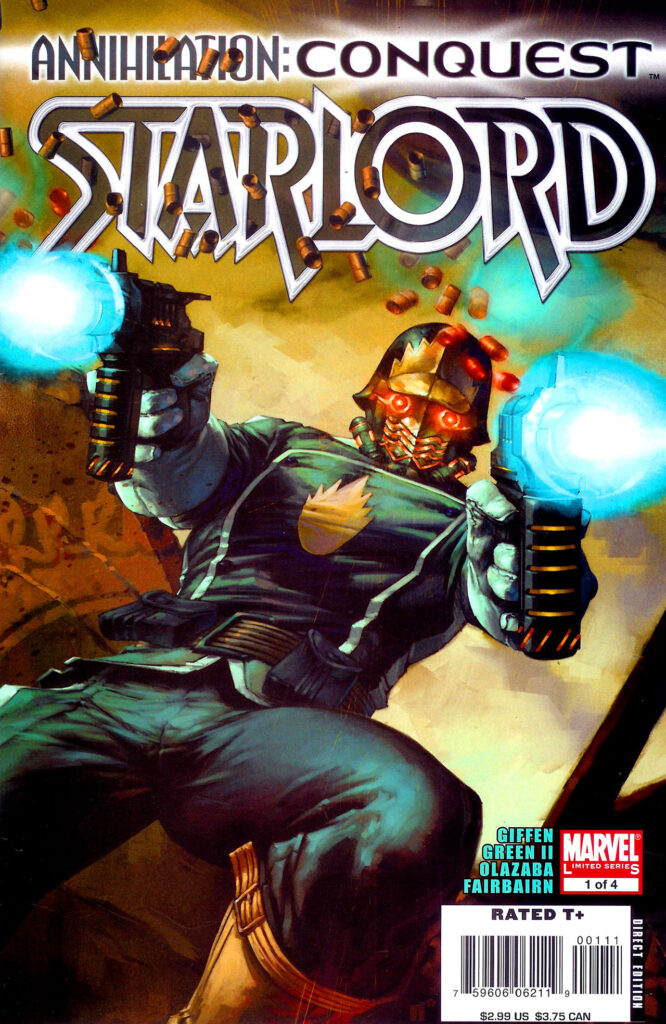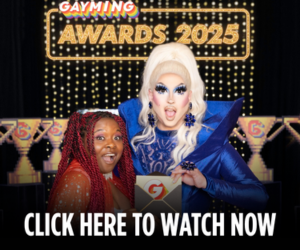Comics Corner – Star-Lord is bisexual, but don’t expect it to matter outside of the comics
In recent days, you may have noticed that the mainstream media latched onto the news that Star-Lord, leader of the Guardians of the Galaxy, was shown to be bisexual. Not only that but, after being seemingly killed in the opening issues of the current volume of Guardians of the Galaxy comic, he was in fact alive in an alternate reality, and engaged in a polyamorous relationship there.
The revelations, which came in last week’s Guardians of the Galaxy #9, were picked up by the likes of Entertainment Weekly, BuzzFeed, and even The Independent. However, while outlets made clear the events referred to the comic, all centred their coverage on the cinematic version of the character, played in the Marvel Cinematic Universe by actor Chris Pratt. Sadly though, we’re unlikely to see Star-Lord’s sexuality reflected on screen, and there are a few reasons why not.
Firstly, the version of Star-Lord that appeared in 2014’s Guardians of the Galaxy film is already very different to any version of the comic book hero – there have been several, and pretty much all of them have complicated backstories.

The original Star-Lord appeared in Marvel Preview #4 in 1974, created by writer Steve Englehart and artists Steve Gan and Bob McLeod, and was conceptually inspired by pulp sci-fi heroes such as Flash Gordon. Although named Peter Quill, like the character movie-goers would become familiar with, this version of the hero existed on a different Earth to the one inhabited by the likes of the Avengers.
This version of Star-Lord was born under a celestial convergence – one that has his arrival compared to the birth of Christ – and was later recruited as A Star-Lord by the mysterious Master of the Sun. Gifted an advanced space suit and a powerful weapon called the Element Gun, capable of firing the four cardianl elements of earth, fire, wind, and water, the newly minted Star-Lord went on to be a sort of space patrolman. This is similar to the premise of author E.E. ‘Doc’ Smith’s 1930s Lensman series, where highly evolved aliens recruit less advanced races to be their agents in maintaining cosmic order (Lensman would also influence DC’s Green Lantern mythos).
Later stories would see Star-Lord gain a sentient spaceship, named merely Ship, and learn that his father was an alien named Jason of Sparta. Years later, a new Starlord named Sinjin Quarrel would inherit this Peter Quill’s armour, Element Gun, and Ship, although both Quill and Quarrel would remain fairly niche characters.

In 2004, writer Keith Giffen and artist Ron Lim would introduce another version of Peter Quill in Thanos #8, existing in the core Marvel Universe (known as Earth-616). Giffen played fast and loose with continuity though, implying this version of Star-Lord had already existed and had seen exploits similar to the Englehart character, but since abandoned the identity. When introduced, this take on Quill was a prisoner in the interstellar prison known as the Kyln, and said he had “killed” Star-Lord – in reality, casting aside his mantle and weapons and replacing parts of his body with cybernetic implants.
The 616 Peter Quill would go on to be a major player in the Annihilation storyline, a 2006 event that saw Marvel place renewed emphasis on its space-based and cosmic superheroes, and its sequel, Annihilation: Conquest. The modern-day Guardians of the Galaxy team emerged from the latter crossover – the original team, created in 1969 by Arnold Drake and Gene Colan, inhabited the 31st Century – with Star-Lord leading the team that would go on to inspire the movie line-up: Gamora, Drax the Destroyer, Groot, and Rocket Racoon, plus Quasar, Adam Warlock, and Mantis, a version of whom would eventually join the cinematic team in 2017’s Guardians of the Galaxy Vol. 2.
That’s already a fairly confusing balancing act – two versions of the same character, one implied to be the other even though the original 1970s stories didn’t fit with the 616 Marvel Universe. It’s more than understandable that writer-director James Gunn streamlined the character of Star-Lord for the films, keeping aspects such as his connection to space via a mysterious father, and sending him to the Kyln prison, but abandoning almost everything else – his uniform, Ship, the Master of the Sun, and even his Element Gun.
However, streamlining for the film, which went on to be a huge success, made for an even more confusing backlash in the comics, as Marvel struggled to make the print version of Star-Lord better reflect the on-screen character. His origin was retconned, more closely mimicking the movie’s telling where Quill is abducted by aliens as a child and raised by the space pirate Yondu, and his personality shifted from the battle-hardened veteran of the Annihilation wars to something closer to Chris Pratt’s snarky, roguish space-slacker.

In 2013’s volume three of the Guardians of the Galaxy comic, writer Brian Michael Bendis and artist Steve McNiven began to fold in parts of the 1970s Star-Lord back into the 616 Peter Quill. Most notable was the introduction of Peter’s father, J’son of Spartax, an update on the aforementioned Jason of Sparta. The Master of the Sun remained absent. Yet in the film Guardians Vol. 2, Gunn would ignore this and diverge the cinematic Star-Lord even further from his comic book origins, establishing his father as Ego, the Living Planet, a Celestial. By this point, film Star-Lord and comic Star-Lord are essentially completely different characters.
Fast-forward to: the current volume of Guardians of the Galaxy, written by Al Ewing, with art by an assortment of creators including Juan Cabal and Marcio Takara. The ongoing story seems largely to be bridging the gaps between the different iterations of not just Star-Lord, but the various versions of the team itself. The core five characters who front the films are present, along with characters from the Annihilation-era team and some newcomers, including Hercules and Marvel Boy.
Ewing killed off Star-Lord in #2, in battle against reborn Greek Gods gone mad. In true comic book tradition though, no-one stays dead – in fact, Quill’s death was just one step towards a greater rebirth, one that seems to be on track to reconcile the many conflicting elements of his origin.

In the just-released #9, readers find Quill in the strange world of Morinus, awakening after scant recollections of his stand against the Greek gods and strange visions of the Master of the Sun, which clash with memories of his youth as established in the Bendis run. In Morinus, he meets Aradia and Mors, fellow adventurers with whom he eventually forms a bond.
Time passes differently on Morinus though – he spends 144 years there, barely ageing. It’s only after 12 years that Quill gives up on returning to Earth and reuniting with Gamora, his female love interest, and joins with Aradia and Mors in a polyamorous relationship. Decades later, we see that Aradia is pregnant, while Quill has become something of a philosopher or space-mystic. A year after that, an apparent mention of their child, Rocky, is made (although it’s unclear if Quill or Mors is the biological father) just before events force Quill to find a way to return to the core Marvel Universe – where seemingly little time has passed.
Contrary to the more sensational headlines about the relationship, Star-Lord loving Aradia and Mors isn’t treated as a sudden revelation or a case of Quill being bi all along, or having a wider interest in men as well as women. Instead, he forms an incredibly close and personal emotional connection with that specific pair, one that clearly becomes physical. This is another reason the character’s bisexuality is unlikely to expand beyond the printed page – no labels or identities have yet been spoken, and it may be that his feelings are confined to just Aradia and Mors.
There’s also the possibility the events in Morinus didn’t actually happen, though this would admittedly be a cruel swerve for LGBTQ+ readers excited to see more representation in mainstream superhero comics. The words of the Master of the Sun echo through the issue, repeatedly asking Peter “Do you feel the basis for your life is wrong?” This is a question asked of the original Star-Lord, way back in 1974 – right before the Master of the Sun put that version of Peter Quill through a psychadelic series of events in order to purge him of the desire for revenge. If Ewing is, in fact, combining all elements of Star-Lord’s origins back into one (hopefully more coherent) timeline, then the entire sequence could prove to be another psychological “purge”, courtesy of the Master. That said, we suspect a major reason for the sequence was to establish the time difference between Morinus and Earth, and the birth of Rocky, which allows for the introduction of an adult child for Star-Lord in a future issue, one who continued to age after its father left Morinus.

The final reason we don’t expect to see a bisexual Star-Lord on the big screen though is actor Chris Pratt himself. While denying holding homophobic views personally, Pratt’s church reportedly does – something actor Elliot Page called out in 2019. Pratt has also recently been attacked – although defended by his MCU co-stars – for his perceived right-wing leanings. Although Pratt himself has maintained an often frustrating neutrality and silence on political matters, it seems he is at least a small-c religious conservative and perhaps less likely to want to bring that aspect of the character to life.
Combined with director James Gunn’s tendency to streamline the source material (and a polyamorous relationship in an alternate universe after dying fighting Greek gods is exactly the sort of thing Gunn would trim for moviegoers), his already-major diversions from the source material, and the MCU’s focus on Star-Lord and Gamora’s relationship, it’s unlikely that this major development in the comics will amount to even a ripple on the screen.
Whether Star-Lord’s bisexuality sticks around on the page or not though, this isn’t the first time in this run of Guardians of the Galaxy that Ewing has introduced queer characters. Team members Moondragon and Phylla-Vell are a married lesbian couple, while Hercules and Marvel Boy, already both established as bisexual, began a relationship in an earlier issue. The title, thankfully, remains one of Marvel’s most diverse in terms of LGBTQ+ representation.








